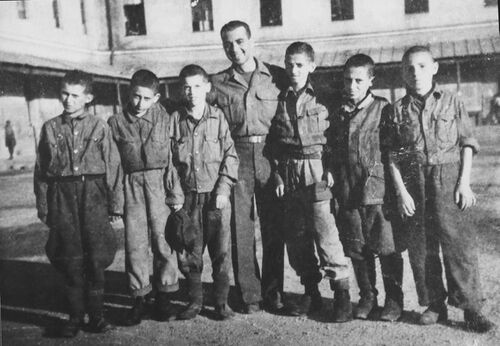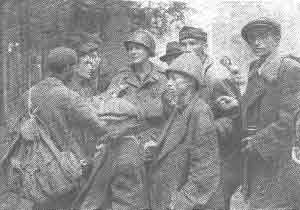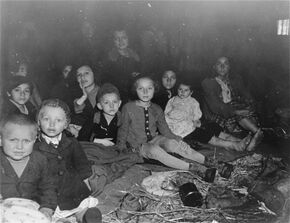Difference between revisions of "Category:Gunskirchen (subject)"
| Line 39: | Line 39: | ||
* [[Edith Eger]] (USHMM) (1927) | * [[Edith Eger]] (USHMM) (1927) | ||
[[File:Gunskirchen Children2.jpg| | [[File:Gunskirchen Children2.jpg|320px]] [[File:Gunskirchen Children.jpg|290px]] | ||
Revision as of 09:45, 31 May 2021
KZ Gunskirchen (see Holocaust Children Studies)
The Liberation of the camp
The 71st Infantry Division liberated Gunskirchen, one of the many subcamps of the Mauthausen concentration camp in Austria.
Construction of the Gunskirchen camp began in December 1944. The camp was planned to house several hundred slave laborers. When the camp was opened in April 1945, however, thousands of prisoners evacuated on death marches from Mauthausen started to flood Gunskirchen. The situation went completely out of control. There was no food, fresh water, sheltering for the thousands of prisoners who arrived at the camp. In these overcrowded conditions, diseases such as typhus and dysentery spread rapidly through the starving and weakened camp population. The prisoners were—with the exception of 400 political prisoners—Jews from Hungary whom the Germans had forced to march on foot from their homeland to Austria, where they were to be used for forced labor. Some 17,000 Hungarian Jews reportedly passed through the Gunskirchen camp.
When troops of the 71st entered the camp, they learned that the SS guards had fled the corpse-littered camp days before. Some 15,000 prisoners were still in the camp. In the months following the liberation, some 1,500 former prisoners died as a consequence of their mistreatment by the Nazis.
The Kovno Boys
Among the numerous children who were liberated at Gunskirchen were 37 Kovno Boy.
In July 1944, at the liquidation of the Kovno Ghetto, 131 boys were separated from the parents and sent to Auschwitz. At Auschwitz two main selections progressively reduced their number. On January 18, 1945, the remaining 39 boys were forced into a death march to Mauthausen and then in mid-April to Gunskirchen, where 37 boys were liberated by American soldiers.
The group of 37 survivors at Gunskirchen included:
- Leib Braverman (1929)
- Daniel Chanoch (1933)
- Yehuda Feigin (1931)
- Shlomo Galperin (1931)
- Meir Gecht (1929-2011)
- Zundel Gordon (1929)
- Dan Labanovski (1933)
- Shlomo Levin (1931?)
- Moshe Shoham (1929-2013)
- + Kalman Arieli (1928), who had joined the group only later at Auschwitz.
Pictured in the center is Max Wolfson, an American Jewish liberator. He poses with six "Kovno Boys" in the Gunskirchen concentration camp after Liberation. The six children are (from the right to the left): Leib Zieman, Kalman Tsechenowski, Meir Gecht, Elizier Greiss, Mordechai Levitan, and Daniel Lebanovski. (@USHMM)
Other children
Numerous other children were liberated at Gunskirchen, coming from other camps, incuding twins Ibolya & Imre Feuerstein:
- Edith Eger (USHMM) (1927)
Pages in category "Gunskirchen (subject)"
The following 33 pages are in this category, out of 33 total.
1
- Edith Eger
- Helen Balsam (F / Poland, 1927), Holocaust survivor
- Sini Adler (M / Czechia, 1928), Holocaust survivor
- Wolfgang Adler
- Kalman Arieli / Kalma Aharonowitch (M / Lithuania, 1928), Holocaust survivor
- Asher Aud / Anshel Sieradzki (M / Poland, 1928-2016), Holocaust survivor
- Michael Gluck (M / Hungary, 1928), Holocaust survivor
- Judy Lysy
- Leib Zieman
- Yehuda Bacon (Czechia, 1929), Holocaust survivor
- Leib Braverman (M / Lithuania / 1929), Holocaust survivor
- Meir Gecht (M / Lithuania, 1929-2011), Holocaust survivor
- Zundel Gordon (M / Lithuania, 1929), Holocaust survivor
- Elizier Greiss
- Jehuda Gurvic
- Akiva Kohane (M / Poland, 1929), Holocaust survivor
- Moshe Shoham (M / Lithuania, 1929-2013), Holocaust survivor
- Kalman Tsechenowski / Kalman Ciechanowski (M / Poland, 1929), Holocaust survivor
- Martin Weiss (M / Czechia, 1929), Holocaust survivor
- Simon Braitman (M / Poland, 1930-2021), Holocaust survivor
- Hugo Gryn (M / Slovakia, 1930), Holocaust survivor
- Michal Kraus (M / Czechia, 1930), Holocaust survivor
- David Leitner (M / Hungary, 1930), Holocaust survivor
- Mordechai Levitan / Motel Levitanas (M / Lithuania, 1930), Holocaust survivor
- Yehuda Feigin (M / Lithuania, 1931), Holocaust survivor
- Shlomo Galperin (M / Lithuania, 1931), Holocaust survivor
- Shlomo Levin (M / Lithuania, 1931), Holocaust survivor
- Adele Rubinstein (F / Hungary, 1931), Holocaust survivor
- Pavel Werner
- Daniel Chanoch (M / Lithuania / 1933), Holocaust survivor
- Frank Grunwald / Misa Frantisek Grunwald (M / Czechia, 1933), Holocaust survivor
- Abraham Klavansky / Abraham Klavanskis / Arnold Clevs (M / Lithuania, 1933), Holocaust survivor
- Dan Labanovski (M / Lithuania, 1933), Holocaust survivor


